What's New
Displaying results 3881 - 3890 of 4914
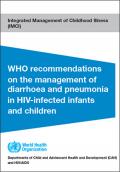
Resource | Guidelines,
The main causes of death among children under 5 years of age are acute respiratory infection (17%) and diarrhoeal disease (16%), and children infected with human immunodeficiency virus (HIV) have greater morbidity and mortality related to these conditions (WHO, 2008).
The World Health Organization (WHO) departments of Child and Adolescent Health and of HIV/AIDS reviewed the evidence on management of diarrhoea and pneumonia in HIV-infected children, because of the substantial effects of these conditions on morbidity and mortality, potential differences in etiological agents (and thus in recommended empirical regimens) from those for uninfected infants and children, potential changes in the susceptibility of pathogens to co-trimoxazole prophylaxis in these children, and the lack of specific recommendations for this high-risk group. These guidelines are part of a comprehensive set of normative documents being prepared by WHO for the prevention and treatment of common conditions affecting HIV-infected and -exposed infants and children.
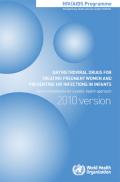
Resource | Guidelines,
The 2010 guidelines are developed to provide international standards, primarily for low- and middle income settings, in support of the global scale-up of more effective interventions aimed at preventing mother-to-child transmission of HIV (MTCT) in resource-limited settings. Once implemented, these recommendations could reduce the risk of MTCT to less than 5% (or even lower) in breastfeeding populations from a background risk of 35%, and to less than 2% in non-breastfeeding populations from a background risk of 25%, and will ensure increased maternal and child survival.
The 2010 revision of the WHO guidelines on prevention of mother-to-child transmission of HIV (PMTCT) complies with the recently updated WHO guidelines development process, which requires systematic review of new evidence for key questions and recommendations, as well as a consideration of programme feasibility and the cost implications of potential new recommendations. WHO has simultaneously revised guidelines for adult ART as well as HIV and infant feeding. All three sets of guidelines were updated in a harmonized fashion.

Resource | Publications,
The latest studies show that a reduction in new HIV infections of up to a third could be achieved globally if there is a radical overhaul of the way that the world provides antiretroviral therapy and if global leaders meet their commitments of ensuring that all people in need of treatment are on it.
It's called treatment as prevention and it is one of the five pillars of the new Treatment 2.0 platform. In an effort to maximize the value of antiretroviral therapy, a radically simplified approach is needed. This includes the development of better combination treatment regimens, cheaper and simplified diagnostic tools, and a low-cost community-led approach to delivery.
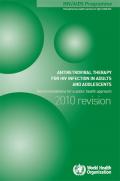
Resource | Guidelines,
Since the publication in 2006 of Antiretroviral therapy for HIV infection in adults and adolescents: Recommendations for a public health approach, new evidence has emerged on when to initiate ART, optimal ART regimens, the management of HIV coinfection with tuberculosis and chronic viral hepatitis and the management of ART failure. This evidence formed the basis for the recommendations contained in the 2010 update, which outlines a public health approach to the delivery of ART for adults and adolescents in settings with limited health systems capacity and resources. The recommendations were based on the preparation GRADE evidence profiles, systematic and targeted reviews, risk-benefit analyses, consultations with PLHIV, technical reports, and assessments of impact, feasibility and cost.
This guideline revision was conducted in accordance with procedures outlined by the WHO Guidelines Review Committee and is based on the GRADE approach to evidence review. The process involved four separate working groups: the Internal WHO ART Guideline Working Group, the ART Guideline Drafting Group, the external ART Peer Review Panel and the full ART Guideline Review Committee.
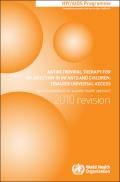
Resource | Guidelines,
Significant obstacles remain to scaling up paediatric care, including limited screening for HIV, a lack of affordable, simple diagnostic testing technologies for children less than 18 months of age, a lack of human resources with the capacity to provide the care that is required, insufficient advocacy and understanding that ART is efficacious in children, limited experience with simplified, standardized treatment guidelines, and limited availability of affordable and practical paediatric ARV formulations. Health-care systems remain unable to meet the demands of national paediatric ART coverage. Consequently, far too few children have been started on ART in resource-limited settings. Moreover, the need to treat an increasing number of HIV-infected children highlights the primary importance of preventing transmission of the virus from mother to child in the first place.
The WHO guidelines Antiretroviral therapy for HIV infection in infants and children are based on a public health approach to HIV care. Updated in 2010, these guidelines are harmonized with the treatment guidelines adopted for adults, pregnant women, and for prevention of mother- to- child transmission (PMTCT).
The present guidelines are part of WHO’s commitment to achieve universal access to the prevention, care and treatment of HIV infection in infants and children.

Resource | Publications,
Stigma and discrimination surrounding HIV/AIDS pose critical barriers to prevention, treatment, care and support programs. There is currently little reliable data or documentation relating to stigma and discrimination against people living with HIV (PLHIV) in Cambodia.
The study was carried out in five selected provinces where a total number of 394 PLHIV were interviewed, 71% of whom are females and 29% of whom are males. About 80% of respondents were aged 30-49 years. The gender and age profiles of respondents maybe reflective of the large proportion of respondents who belonged to self-help groups and not of the PLHIV population in general. There was a low level of schooling (75% received either no schooling or primary schooling only) and >70% of respondents were working as farmers or sellers. The study methodology included a quantitative method based on the global HIV Stigma Index questionnaire and a qualitative method which involved focus group discussions and key informant interviews.
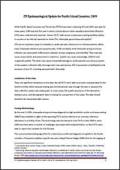
Resource | Publications,
While Pacific Island Countries and Territories (PICTs) have been collecting HIV and AIDS case data for many years, 2009 was the first year in which routine data on other sexually transmitted infections (STIs) were collected and reported. Eleven PICTs with access to laboratory testing facilities (either in country or by referral) reported on three STIs; chlamydia, gonorrhoea and syphilis.
STIs are an important cause of morbidity in adults and also infants born to infected parents. While many chlamydia infections are asymptomatic, if left untreated, both chlamydia and gonorrhoea infection can cause pelvic inflammatory disease, ectopic pregnancy and infertility. They may also cause conjunctivitis and pneumonia in newborns. Syphilis can cause miscarriage, stillbirth and congenital syphilis. The latter may cause irreversible damage to cardiovascular and nervous system of the newborn infected child. Amongst both men and women, HIV transmission is facilitated by the presence of any STI, including asymptomatic chlamydia.
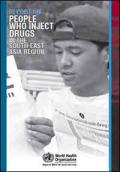
Resource | Publications,
Since the 1990s the majority of countries in the South-East Asia Region have experienced a significant injecting drug use problem, accompanied by explosive rates of HIV at some sites. Over time the national response has increasingly been to implement various harm reduction interventions to reduce the HIV prevalence and address the health needs of people who inject drugs (PWID). This assessment examines the current situation of HIV and injecting drugs and of the national responses. The focus is on countries with a high and medium burden of illicit drug injecting. In most of these countries PWID are either HIV infected or have the potential for being infected. The countries reviewed are Bangladesh, India, Indonesia, Maldives, Myanmar, Nepal and Thailand.

Resource | Publications,
In essence, the present document describes the priority health sector interventions recommended to achieve universal access for the prevention, treatment, care and support of HIV and sexually transmitted infections among MSM in the broader perspective of male sexual health. It summarizes key policy and technical recommendations developed by WHO related to each priority health sector intervention. It guides the selection and prioritization of interventions for HIV prevention, treatment, care and support. Finally, it directs readers to key resources of WHO and other organizations containing the best available information on the health sector response to HIV among MSM.
Relying on a rigorous background of male sexual health and strategic information, this document is, to the extent possible, based on scientific evidence and programmatic experience in prevention, care, support and treatment of HIV, as well as male sexual health. It is also intended to be as specific as possible for its implementation in the context of Asia and the Pacific, addressing a broad audience including public health decision-makers, national AIDS programme managers, health care providers, community-based organization managers, MSM living with and affected by HIV, and development agencies.

Resource | Publications,
Since their inception in 2003, UNDP’s Asia-Pacific Human Development Reports have been stimulating a lively dialogue within the region on a range of important issues. Prepared by experts from Asia and the Pacific, the Reports present an authentic account of human development progress, possibilities, and challenges in this vibrant and fastgrowing region.
This year’s Report focuses on the critical question of advancing gender equality, as seen through the prism of women’s unequal power, voice, and rights. Despite the region’s many economic gains, the Report chronicles how in many instances women across the region continue to be held back and disadvantaged. Even as many women have benefited from their countries’ improved education, health, and prosperity, they continue to face barriers to the same opportunities available to men.





